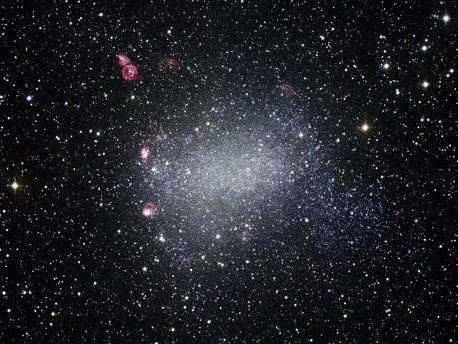Barnard's Galaxy
Our Tiny but Tough Galactic Neighbor
 © ESO |
this dwarf irregular galaxy is one of the Milky Way’s galactic neighbors. The dwarf galaxy has no shortage of stellar splendor and pyrotechnics. Reddish nebulae in this image reveal regions of active star formation, wherein young, hot stars heat up nearby gas clouds. Also prominent in the upper left of this new image is a striking bubble-shaped nebula. At the nebula’s center, a clutch of massive, scorching stars send waves of matter smashing into surrounding interstellar material, generating a glowing structure that appears ring-like from our perspective. Other similar ripples of heated matter thrown out by feisty young stars are dotted across Barnard’s Galaxy.
In the new ESO image, Barnard’s Galaxy glows beneath a sea of foreground stars in the direction of the constellation of Sagittarius (the Archer). At the relatively close distance of about 1.6 million light-years, Barnard’s Galaxy is a member of the Local Group, the archipelago of galaxies that includes our home, the Milky Way. The nickname of NGC 6822 comes from its discoverer, the American astronomer Edward Emerson Barnard, who first spied this visually elusive cosmic islet using a 125-millimetre aperture refractor in 1884.
Astronomers obtained this latest portrait using the Wide Field Imager (WFI) attached to the 2.2-metre MPG/ESO telescope at ESO’s La Silla Observatory in northern Chile. Even though Barnard’s Galaxy lacks the majestic spiral arms and glowing, central bulge that grace its big galactic neighbours, the Milky Way, the Andromeda and the Triangulum galaxies, this dwarf galaxy has no shortage of stellar splendour and pyrotechnics. Reddish nebulae in this image reveal regions of active star formation, where young, hot stars heat up nearby gas clouds. Also prominent in the upper left of this new image is a striking bubble-shaped nebula. At the nebula’s centre, a clutch of massive, scorching stars send waves of matter smashing into the surrounding interstellar material, generating a glowing structure that appears ring-like from our perspective. Other similar ripples of heated matter thrown out by feisty young stars are dotted across Barnard’s Galaxy.
At only about a tenth of the Milky Way's size, Barnard’s Galaxy fits its dwarfish classification. All told, it contains about 10 million stars — a far cry from the Milky Way’s estimated 400 billion. In the Local Group, as elsewhere in the Universe, however, dwarf galaxies outnumber their larger, shapelier cousins.
Irregular dwarf galaxies like Barnard’s Galaxy get their random, blob-like forms from close encounters with or "digestion" by other galaxies. Like everything else in the Universe, galaxies are in motion, and they often make close passes or even go through one another. The density of stars in galaxies is quite low, meaning that few stars physically collide during these cosmic dust-ups. Gravity's fatal attraction, however, can dramatically warp and scramble the shapes of the passing or crashing galaxies. Whole bunches of stars are pulled or flung from their galactic home, in turn forming irregularly shaped dwarf galaxies like NGC 6822.
Credit: ESO
Barnard's Galaxy
Our Tiny but Tough Galactic Neighbor
 © ESO |
this dwarf irregular galaxy is one of the Milky Way’s galactic neighbors. The dwarf galaxy has no shortage of stellar splendor and pyrotechnics. Reddish nebulae in this image reveal regions of active star formation, wherein young, hot stars heat up nearby gas clouds. Also prominent in the upper left of this new image is a striking bubble-shaped nebula. At the nebula’s center, a clutch of massive, scorching stars send waves of matter smashing into surrounding interstellar material, generating a glowing structure that appears ring-like from our perspective. Other similar ripples of heated matter thrown out by feisty young stars are dotted across Barnard’s Galaxy.
In the new ESO image, Barnard’s Galaxy glows beneath a sea of foreground stars in the direction of the constellation of Sagittarius (the Archer). At the relatively close distance of about 1.6 million light-years, Barnard’s Galaxy is a member of the Local Group, the archipelago of galaxies that includes our home, the Milky Way. The nickname of NGC 6822 comes from its discoverer, the American astronomer Edward Emerson Barnard, who first spied this visually elusive cosmic islet using a 125-millimetre aperture refractor in 1884.
Astronomers obtained this latest portrait using the Wide Field Imager (WFI) attached to the 2.2-metre MPG/ESO telescope at ESO’s La Silla Observatory in northern Chile. Even though Barnard’s Galaxy lacks the majestic spiral arms and glowing, central bulge that grace its big galactic neighbours, the Milky Way, the Andromeda and the Triangulum galaxies, this dwarf galaxy has no shortage of stellar splendour and pyrotechnics. Reddish nebulae in this image reveal regions of active star formation, where young, hot stars heat up nearby gas clouds. Also prominent in the upper left of this new image is a striking bubble-shaped nebula. At the nebula’s centre, a clutch of massive, scorching stars send waves of matter smashing into the surrounding interstellar material, generating a glowing structure that appears ring-like from our perspective. Other similar ripples of heated matter thrown out by feisty young stars are dotted across Barnard’s Galaxy.
At only about a tenth of the Milky Way's size, Barnard’s Galaxy fits its dwarfish classification. All told, it contains about 10 million stars — a far cry from the Milky Way’s estimated 400 billion. In the Local Group, as elsewhere in the Universe, however, dwarf galaxies outnumber their larger, shapelier cousins.
Irregular dwarf galaxies like Barnard’s Galaxy get their random, blob-like forms from close encounters with or "digestion" by other galaxies. Like everything else in the Universe, galaxies are in motion, and they often make close passes or even go through one another. The density of stars in galaxies is quite low, meaning that few stars physically collide during these cosmic dust-ups. Gravity's fatal attraction, however, can dramatically warp and scramble the shapes of the passing or crashing galaxies. Whole bunches of stars are pulled or flung from their galactic home, in turn forming irregularly shaped dwarf galaxies like NGC 6822.
Credit: ESO





